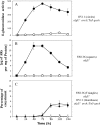Isolation and characterization of Azotobacter vinelandii mutants impaired in alkylresorcinol synthesis: alkylresorcinols are not essential for cyst desiccation resistance
- PMID: 19270099
- PMCID: PMC2681798
- DOI: 10.1128/JB.01575-08
Isolation and characterization of Azotobacter vinelandii mutants impaired in alkylresorcinol synthesis: alkylresorcinols are not essential for cyst desiccation resistance
Abstract
During encystment of Azotobacter vinelandii, a family of alkylresorcinols (ARs) and alkylpyrones (APs) are synthesized. In the mature cyst, these lipids replace the membrane phospholipids and are also components of the layers covering the cyst. In this study, A. vinelandii strains unable to synthesize ARs were isolated after mini-Tn5 mutagenesis. Cloning and nucleotide sequencing of the affected loci revealed the presence of the transposons within the arsA gene of the previously reported arsABCD gene cluster, which encodes a type I fatty acid synthase. A mutant strain (SW-A) carrying an arsA mutation allowing transcription of arsBCD was constructed and shown to be unable to produce ARs, indicating that the ArsA protein is essential for the synthesis of these phenolic lipids. Transcription of arsA was induced 200-fold in cells undergoing encystment, but only 14-fold in aged cultures of A. vinelandii, in accordance with AR synthesis and cyst formation percentages under the two conditions. Although it was previously reported that the inactivation of arsB abolishes AR synthesis and results in a failure in encystment, the arsA mutants were able to form cysts resistant to desiccation. These data indicate that ARs play a structural role in the exine layer of the cysts, but they are not essential for either cyst formation or for desiccation resistance.
Figures





References
-
- Alexeyev, M. F., I. N. Shokolenko, and T. P. Croughan. 1995. Improved antibiotic-resistance gene cassettes and omega elements for Escherichia coli vector construction and in vitro deletion/insertion mutagenesis. Gene 16063-67. - PubMed
-
- Bush, J. A., and P. W. Wilson. 1959. A Non-gummy chromogenic strain of Azotobacter vinelandii. Nature 184381. - PubMed
Publication types
MeSH terms
Substances
LinkOut - more resources
Full Text Sources
Molecular Biology Databases
Research Materials
Miscellaneous

